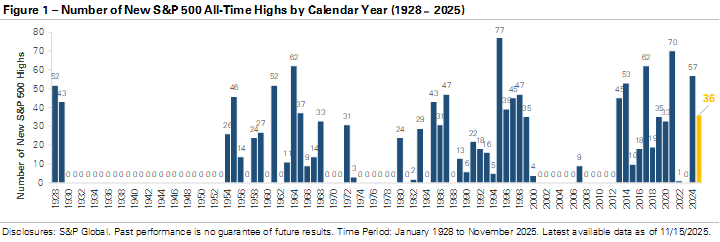"Go for a business that any idiot can run - because sooner or later any idiot probably is going to be running it." ― Peter Lynch
The stock market is having another record-setting year. The chart below shows that the S&P 500 has set 36 new highs since the start of the year. While it’s a decline from last year’s pace, the number of new highs in 2025 ranks 18th compared to the past 98 years. The S&P 500’s strong performance this year is part of a broader equity market trend, with multiple other major equity indices also setting new highs. The Nasdaq has logged 36 new highs, the Dow Jones has posted 17, and the small-cap Russell 2000 has recorded six new highs after finally surpassing its 2021 peak.
A combination of themes is contributing to the stock market’s lengthy list of new highs, with the most notable being the artificial intelligence boom. Companies are spending hundreds of billions on infrastructure to train AI models, build data centers, and source the energy to run it all. Nvidia recently became the first company to surpass a $5 trillion market cap, and leading technology firms like Microsoft, Amazon, Alphabet, and Meta are reporting strong growth tied directly to demand for their cloud computing services. The industry’s momentum and forecasts for continued strong growth are driving AI stocks higher, and their large index weights are helping to push the broader markets to all-time highs despite narrow market leadership. To put the rally into perspective, the market-cap-weighted Russell 1000 Index is up +14% year-to-date. The equal-weight version of the index is up +6%, and the median stock has gained just +2%. Beneath the surface, nearly half the index is in the red, with 462 companies down year-to-date.
While AI is getting the most attention, several other catalysts have contributed to the market’s strength. After a 9-month pause, the Federal Reserve restarted its rate-cutting cycle in September, lowering interest rates by -0.50% over the past two months. Lower borrowing costs and expectations for additional rate cuts have provided a tailwind for stocks. At the same time, the U.S. economy has remained resilient in the face of multiple headwinds, including trade policy and tariffs, geopolitical tensions, and a government shutdown. Corporate earnings growth remains strong, and Q3 earnings exceeded expectations.
This year has shown the value of staying invested through uncertainty. Trade tensions and policy uncertainty have created periods of market volatility, and if investors had known the headlines before the year began, they may have been tempted to sell. However, doing so would have meant missing out on the S&P 500’s nearly +15% return and long list of new highs. Timing the market is difficult and often costly, and it can lead to missed opportunities that make it difficult to meet your financial goals. Each year brings its own reminders of core financial planning principles. If 2025 underscored the importance of staying invested, 2026 may highlight the importance of portfolio diversification.

IMPORTANT DISCLOSURES
Clare Market Investments, LLC is a Registered Investment Advisor. This material is for informational purposes only. It is not intended as and should not be used to provide investment advice and is not an offer to sell a security or a recommendation to buy a security. The information is derived from sources believed to be reliable and accurate as of the date of this report, but Clare Market has not audited this information to validate accuracy. Further, information may be at a point in time and subject to change. This summary is based exclusively on an analysis of general market conditions and does not speak to the suitability of any specific proposed securities transaction or investment strategy. Judgments or recommendations found in this report may differ materially from what may be presented in a long-term investment plan and are subject to change at any time. This report’s authors will not advise you as to any changes in figures or views found in this report. Investors should consult with their investment advisor to determine the appropriate investment strategy and investment vehicle. Investment decisions should be made based on the investor’s specific financial needs and objectives, goals, time horizon, and risk tolerance. Except for the historical information contained in this report, certain matters are forward-looking statements or projections that are dependent upon risks and uncertainties, including but not limited to such factors and considerations such as general market volatility, global economic risk, geopolitical risk, currency risk and other country-specific factors, fiscal and monetary policy, the level of interest rates, security-specific risks, and historical market segment or sector performance relationships as they relate to the business and economic cycle. See claremarket.com for additional information and disclosures. © 2025 Clare Market Investments, LLC. All Rights Reserved.
